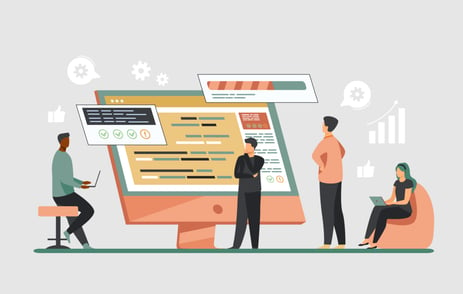Associations have many moving parts – marketing, billing, member data and more. While organizations have staff that can handle all these tasks, without a central system, you’re left working with a bunch of different platforms that all need to communicate somehow.
Enter association management software.
Chances are you’ve heard the term, but what is it exactly, why would you want to use one and what do you need to know when choosing one for your organization? Here is everything you need to know about AMS platforms.
What Is an AMS?
Association management software, more commonly known as an AMS, is an all-in-one system designed to help associations manage every aspect of their businesses.
So, what does it manage exactly?
Depending on the AMS you opt for, it can help your organization with:
- Member Data – Data is critical to your organization, whether it’s your members, vendors or prospects. An AMS creates a centralized location for all that information to live while also creating an opportunity to gather more details. Characteristics like roles, organizations, renewal dates and even content preferences make it easier for your organization to personalize experiences.
- Payments & Financials – From member dues to course registration, you want an easy way to streamline payments. Not only can an AMS handle this, but it can use the member database to help identify lapsed membership and send payment reminders. Additionally, many systems have an option to export reports, which can make it easier to track growth and trends for your dues and non-dues revenue.
- Marketing Automation – Email can be valuable for member engagement and retention. Automation can become your best friend with an AMS, streamlining dues reminders, new content offerings and upcoming events. Additionally, with better member segmentation in place, you can once again customize these automations for a personalized membership experience.
- Content Management – From building entire websites to simply managing and posting to your association blog, many association management systems also include a CMS. If your organization already has a site in place, it can be transferred over or, at the very least, linked to manage it from within your AMS.
- Events – As many organizations look to provide more on-demand and virtual content, having a platform that can be used to plan, host and market a new event can make the process easier. Generally speaking, you should be able to link your AMS to your event platform, making it easy to transfer attendee data or event payments.
- Professional Development – Continuing education, bootcamps and webinars are valuable offerings for many associations. Organizations can connect their LMS to their AMS to track progress in courses and earned certifications and accolades with specific integrations.
- Community Building – Your association should be a hub for all your members. With certain AMS platforms, you get the tools to create that with forums, member directories and even entire online communities (similar to social media), where they can message, connect and interact with like-minded professionals.
AMS vs. CRM vs. MMS
Depending on your experience level in the association industry, or if you’ve dealt with management software in the past, an AMS may sound like a customer relationship management technology (CRM) or membership management software (MMS). However, there are subtle differences between each.
- CRM – a database system used by organizations to manage customer interaction and data over time. These systems often lean more toward a sales focus but can still be used to manage members. They typically store information about customers, prospects, suppliers and partners in a centralized database.
- MMS – a tool to track membership data efficiently through online enrollment forms, automated email campaigns and online payment processing capabilities. These systems typically help organizations engage their members; however, they may be limited by more complex membership offerings (i.e., tiered access or organizational-wide membership).
More often than not, the debate is whether an AMS or CRM is suitable for your organization. While they are similar platforms, the most significant differences often stem from how data is being stored and the organization's goal.
“CRM systems store data that can be used to create stronger customer relationships to increase revenue and grow a business or organization. An AMS stores data that is used to run an association, perform the day-to-day functions of your staff and serve the needs of your members,” says Chris Capastran in an article for Cobalt CRM Solutions.
This is where knowing how to choose association management software and what your organizational goals come into play.
How To Choose Association Management Software
If you’ve determined that an AMS is right for your organization, how do you choose the right one? The first step to selecting an AMS is truly understanding your organization's needs.
Is there a struggle with member communication? Has collecting member dues become an issue? Are you looking to host more events for your members?
Having a good idea of what you need can help identify the features you’re looking for. Outside of that, it's essential to know how to spot a good or bad AMS.
Characteristics of a Good AMS
- Ease of Use – Storing all your data in one platform can be concerning – particularly if it's hard to access or use. Just like you want your members to have a good experience, so should your staff. Whether it’s member data, user analytics or revenue, using a platform with a simple interface is critical.
- Scalability – With all this automation and member engagement, chances are you’ll be growing your members. Not only can more users affect performance, but also it can change your costs (some AMS systems based fees on members). As such, having a platform that can scale with you should be a priority.
- Synching Capabilities – An AMS may be intended to serve all your needs, but it’s only as good as its integration capabilities. Your organization will need it to ingratiate with platforms like event registration software and your LMS platform, so finding one that works with your existing infrastructure is crucial.
- Member Interface – Depending on the capabilities of your AMS, there are plenty of touchpoints with your members. From email automation to social communities, a quality AMS will have user-friendly features that reduce friction and help your members have a personalized experience.
Warning Signs of a Bad One
- Data Security – As more organizations rely on the cloud to store highly sensitive data, knowing what security your AMS has in place is more important than ever. If you’re worried about vulnerabilities, have already had your member data hacked or simply don’t see a plan in place, this can be a major red flag.
- Manual Tasks – The whole point of an AMS is to automate and streamline much of the data entry and manual processes for your organization. Does your software not offer automation tools? Are you manually importing event data to update your member database? The more work you’re doing manually, the less effective your AMS.
- Outdated Integrations – AMS platforms often drop new versions as technology evolves. And while updates are generally a good thing, updates that break existing custom integrations are not. A platform that is inflexible with new technology implementation is never a good thing, especially when it impacts the infrastructure you already have in place.
- Poor Insights – In the words of Peter Drucker, “what gets measured gets managed.” If it’s difficult for your staff to find actionable metrics or if it's a tedious process to parse through or export data, there’s a problem. Although your AMS may track a lot of the data for your organization, is it hiding actual insights with cluttered data?
What Are the Benefits of an AMS?
Although investing in an all-in-one solution for your association operations can be a major expense, the benefits often outweigh the initial costs. Some of these perks include:
- Cost-effective – An AMS is more cost-effective than hiring someone full-time to do everything an AMS can do. Plus, these systems often get updated, meaning you’re always getting the latest tools.
- Time-saving – Having a virtual tool to take care of tasks that would typically take up hours of the day for your staff can free up time for more important things like member engagement and growth.
- Better Security – Whether you’re worried about your member data, payment information or accreditation, you’re adding another layer of security to your member benefits by securing all that information within your AMS (but make sure you vet the AMS platform’s cybersecurity, too).
- More Insights – The more insights you have, the better you can serve your members. Most AMS have data-rich reporting that lets you find trends, track growth monthly or annually, and see that information on a larger scale.
What’s an AMS Alternative?
Of course, an AMS isn’t the right fit for all organizations. While this software offers an all-in-one solution with various tools for associations, that doesn’t necessarily mean they’re the best at what they do.
One way to get around that is by stringing together a collection of best-in-class platforms, such as we’re building for Sidecar.
This method allows organizations to pick and choose the tools that work best for their needs. For example, at Sidecar, we use Airmeet for our events and HubSpot for our CRM, which provides more customization and features when compared to an all-in-one platform.
Not only does this give you flexibility in managing member data and customizing the user experience, but it also makes it much easier to transition to different platforms as one change doesn’t wholly impact all the software you use. Perhaps most importantly, it also allows you to own and manage every piece of your member data, as opposed to putting it in the hands of third-parties. That means you can control data security much more carefully.
How Much Does Association Management Software Cost?
For any association, AMS conversations begin and end with cost. As nonprofits, investing large sums of money requires buy-in and approval from the board of directors, which means having as much information as possible upfront can make the process easy.
However, getting an answer about an association management software’s cost isn’t easy.
What Goes Into AMS Pricing?
Most AMS pricing is customized based on the needs of the organization and a few crucial factors like:
- The features and applications needed.
- The size of the organization.
- How many users and members will use the platform.
- Where the data is hosted (in the cloud or a physical server).
- Support time – both during integration and ongoing.
Additionally, your contract structure will often depend on whether you’re billed monthly or annually, the term lengths and the amount of work that goes into the initial integration. Although an AMS offers plenty of tools and flexibility, the initial import of your existing system may require a large number of resources, which is why making the right choice the first time is essential.
Put simply, you should expect customized pricing when reviewing AMS platforms.
Bringing Software To Your Organization
Software plays a vital role in the operation of your association. Not only does it facilitate day-to-day tasks like billing and marketing, but also it impacts your member’s experience on your platform.
Although there are plenty of options in the association industry, association management software offers an all-in-one solution to these needs. Like any investment for your organization, however, it's important to keep a few factors in mind when shopping for an AMS.
- Understand the needs of your organization.
- Consider the pros and cons of the software.
- Check your pricing and integration.
- Understand that there are alternatives to AMS software.
An AMS can offer plenty of benefits to your organization, but choosing one that’s the ideal fit is key for a long-lasting and successful solution for your association.

August 30, 2022


